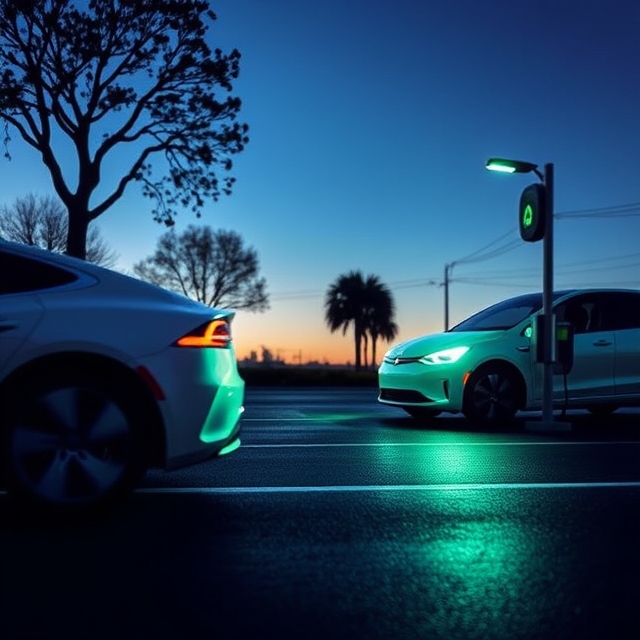In recent years, electric vehicles (EVs) have emerged as a revolutionary force in the automotive industry. As concerns over climate change, air pollution, and the depletion of natural resources grow, EVs present a promising solution to reduce our dependence on fossil fuels and transition to a cleaner, more sustainable mode of transportation. From their environmental benefits to their innovative technology, electric vehicles are shaping the future of mobility in ways that could significantly transform the world we live in.
What Are Electric Vehicles?
Electric vehicles are vehicles that use one or more electric motors for propulsion, powered by electricity stored in batteries. Unlike traditional vehicles that rely on internal combustion engines (ICE), EVs operate by converting electrical energy into mechanical energy, making them fundamentally different in terms of both design and operation.
There are different types of electric vehicles, including:
- Battery Electric Vehicles (BEVs): These vehicles run entirely on electricity stored in batteries, with no gasoline or diesel engines. They are recharged through an electric grid.
- Plug-in Hybrid Electric Vehicles (PHEVs): These vehicles combine a traditional internal combustion engine with an electric motor, which can be recharged through an electric grid. They can run on electricity for short distances and switch to gasoline for longer trips.
- Hybrid Electric Vehicles (HEVs): HEVs are powered by both an internal combustion engine and an electric motor, but unlike PHEVs, they cannot be recharged via an electric grid. The electric motor assists the engine to improve fuel efficiency.
The Benefits of Electric Vehicles
The rise of electric vehicles is driven by a variety of environmental, economic, and technological benefits that they offer over traditional gasoline or diesel-powered vehicles.
1. Environmental Impact
One of the most significant advantages of EVs is their positive impact on the environment. Here are the key environmental benefits:
- Reduction in Greenhouse Gas Emissions: EVs produce zero tailpipe emissions, significantly reducing the number of harmful pollutants like carbon dioxide (CO2), nitrogen oxides (NOx), and particulate matter that contribute to global warming and climate change.
- Cleaner Air Quality: Traditional vehicles with internal combustion engines emit pollutants that contribute to smog, respiratory issues, and environmental degradation. By replacing gasoline and diesel engines with electric power, air quality can dramatically improve, particularly in urban areas.
- Reduction in Noise Pollution: Electric vehicles are much quieter than conventional vehicles, reducing noise pollution, especially in congested city areas.
- Sustainable Energy Use: As the grid becomes greener with an increasing share of renewable energy sources like solar and wind, the overall carbon footprint of EVs continues to decrease. Charging an EV with renewable energy contributes to a more sustainable energy system.
2. Economic Benefits
Electric vehicles offer several economic advantages, both to consumers and the broader economy:
- Lower Operating Costs: EVs have fewer moving parts than traditional vehicles, meaning they require less maintenance and have lower operating costs. There is no need for oil changes, and components like the engine and transmission are less prone to wear and tear. Moreover, electricity is often cheaper than gasoline, making EVs more economical in the long term.
- Government Incentives: Many governments around the world offer financial incentives to encourage the adoption of electric vehicles, including tax rebates, subsidies, and exemptions from certain taxes or fees. These incentives lower the initial purchase price of EVs, making them more accessible to a broader audience.
- Job Creation: The transition to electric vehicles has the potential to create new jobs in industries related to battery manufacturing, charging infrastructure, renewable energy, and EV maintenance.
3. Technological Advancements
Electric vehicles represent the forefront of innovation in the automotive industry. They integrate advanced technologies that enhance performance, safety, and user experience.
- Improved Battery Technology: One of the most significant advancements in EVs has been in battery technology. Modern lithium-ion batteries are lighter, more efficient, and have longer ranges than their predecessors. These improvements have made EVs more practical for everyday use, with many models now offering ranges comparable to traditional vehicles.
- Autonomous Driving Features: Many electric vehicles come equipped with cutting-edge autonomous driving technologies such as lane-keeping assist, adaptive cruise control, and self-parking features. Companies like Tesla have led the charge in developing fully autonomous electric vehicles, potentially transforming the way we drive in the future.
- Smart Features and Connectivity: EVs are equipped with smart features, including over-the-air software updates, real-time data monitoring, and integration with mobile apps. These technologies allow drivers to manage their EVs more efficiently, from checking battery status to scheduling charging times.
4. Energy Independence
As the global demand for oil continues to rise, countries are becoming increasingly dependent on foreign energy sources, leading to economic and geopolitical challenges. Electric vehicles, powered by locally generated electricity, can reduce a nation’s reliance on imported oil, contributing to energy security and independence.
Challenges Facing the Widespread Adoption of Electric Vehicles
While electric vehicles offer a promising future, their widespread adoption faces several challenges. These challenges need to be addressed to unlock the full potential of EVs in the global transportation landscape.
1. Charging Infrastructure
One of the main obstacles to the widespread adoption of electric vehicles is the availability and accessibility of charging infrastructure. While many urban areas have seen a rapid expansion of charging stations, rural areas may still lack sufficient infrastructure. Additionally, public charging stations may not always be compatible with every EV model, or the charging speed may be slow, making long-distance travel more challenging.
To overcome this barrier, governments and private companies need to invest heavily in building a robust, nationwide network of fast-charging stations. Innovations in wireless charging and ultra-fast charging technologies could also help improve the EV charging experience.
2. Range Anxiety
Although EV ranges have improved significantly, many potential EV buyers still worry about “range anxiety”—the fear of running out of battery before reaching a charging station. This issue is particularly relevant for those who need to travel long distances frequently or live in regions where charging stations are sparse.
However, advancements in battery technology are addressing this issue, with many modern EVs offering ranges of over 250 miles on a single charge. Additionally, increasing efforts to expand charging networks will help alleviate range anxiety and make EVs more convenient for long-distance travel.
3. Cost of Electric Vehicles
While the overall cost of owning and operating an EV can be lower than a conventional car, the initial purchase price of many electric vehicles can still be higher, particularly for newer models with advanced technology. The high cost of batteries has traditionally been a significant factor in the price difference between EVs and their gasoline counterparts.
As battery technology continues to improve and economies of scale come into play, the cost of electric vehicles is expected to decrease, making them more affordable to a broader range of consumers. Additionally, government incentives play a role in offsetting some of the upfront costs.
4. Battery Disposal and Environmental Impact
While EVs themselves are cleaner, their batteries pose an environmental challenge at the end of their life cycle. Lithium-ion batteries, commonly used in electric vehicles, contain valuable materials like lithium, cobalt, and nickel, but these can be difficult to recycle and may contribute to environmental harm if not disposed of properly.
Efforts are underway to develop more efficient recycling methods and create second-life battery applications, such as using old EV batteries for stationary energy storage systems. Furthermore, research is being conducted to develop solid-state batteries that are more sustainable and have less environmental impact.
The Future of Electric Vehicles
Despite the challenges, the future of electric vehicles looks incredibly promising. As technology continues to evolve, EVs are expected to become more affordable, efficient, and accessible. The growth of renewable energy sources, such as wind and solar power, will make the charging of EVs even cleaner, further reducing their environmental footprint.
Governments, automakers, and consumers alike are increasingly recognizing the importance of transitioning to sustainable transportation options. As a result, electric vehicles are expected to play a central role in the global effort to combat climate change and reduce carbon emissions.
Conclusion: A Cleaner, Greener Tomorrow
Electric vehicles represent not just a technological innovation but a vital step toward a cleaner, greener future. As we continue to face the challenges of climate change and environmental degradation, EVs offer a solution that addresses the need for sustainable mobility. Through government support, technological advancements, and increased consumer adoption, electric vehicles have the potential to revolutionize the automotive industry and contribute to a more sustainable planet for future generations.




